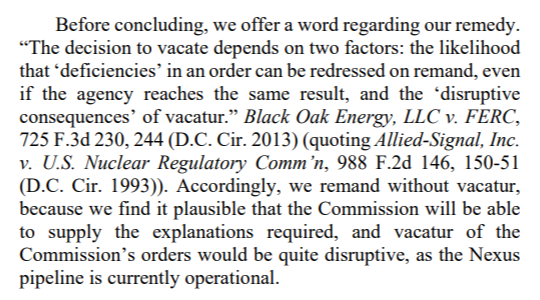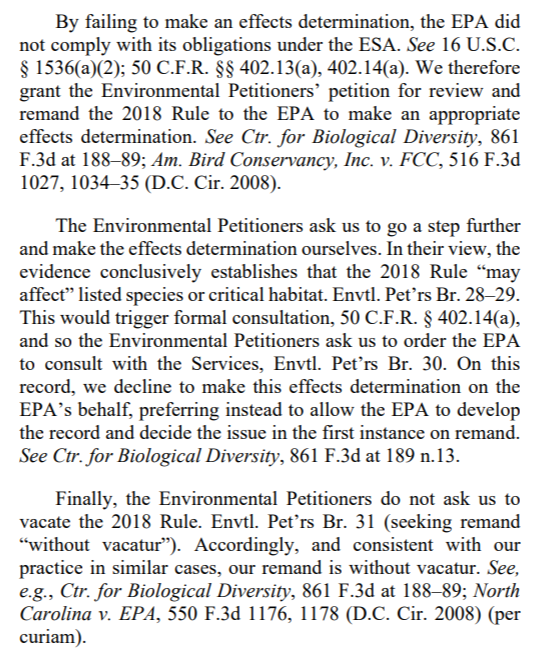D.C. Circuit Review – Reviewed: Vacation?
Section 706(2)(A) of the Administrative Procedure Act states as follows:
To the extent necessary to decision and when presented, the reviewing court shall decide all relevant questions of law, interpret constitutional and statutory provisions, and determine the meaning or applicability of the terms of an agency action. The reviewing court shall … (2) hold unlawful and set aside agency action, findings, and conclusions found to be (A) arbitrary, capricious, an abuse of discretion, or otherwise not in accordance with law.
This prompts a question: What does “set aside” mean?
This question, of course, is a familiar one to those who follow the D.C. Circuit. For you see, the Court has long concluded that “set aside” does not necessarily mean vacatur. The case most associated with that conclusion is Allied-Signal, Inc. v. U.S. Nuclear Regulatory Comm’n, 988 F.2d 146 (D.C. Cir. 1993), which lists two factors to consider in deciding between vacatur or remand without vacatur: Just how “deficient” was the agency’s action, and just how “disruptive” would vacatur be? But is Allied-Signal consistent with the APA? Judge Randolph, for one, doesn’t think so:
Once a reviewing court determines that the agency has not adequately explained its decision, the Administrative Procedure Act requires the court—in the absence of any contrary statute—to vacate the agency’s action. The Administrative Procedure Act states this in the clearest possible terms. Section 706(2)(A) provides that a “reviewing court” faced with an arbitrary and capricious agency decision “shall”—not may—“hold unlawful and set aside” the agency action.
Section 706(2)(A) of the APA could not be clearer: a court faced with an arbitrary and capricious agency rule or order “shall hold unlawful and set aside” that agency action. “Set aside” means vacate, according to the dictionaries and the common understanding of judges, to whom the provision is addressed. And “shall” means “must.” I see no play in the joints.
Judge Sentelle agrees with Judge Randolph:
Having determined that I would reject the Secretary’s compensation scheme, I, like the majority, am left with the question of what remedy is then appropriate. Once again I part company with the majority. I would not simply remand, but would vacate. In my view, “[o]nce a reviewing court determines that the agency has not adequately explained its decision, the Administrative Procedure Act requires the court—in the absence of any contrary statute—to vacate the agency’s action.” Checkosky v. SEC, 23 F.3d 452, 491 (D.C.Cir.1994) (Randolph, J., concurring). As Judge Randolph noted in his opinion in Checkosky, the APA states as much “in the clearest possible terms. [The Act] provides that a ‘reviewing court’ faced with an arbitrary and capricious decision ‘shall … hold unlawful and set aside’ the agency action.” Id. (quoting 5 U.S.C. § 706(2)(A)).
Granted, [some cases] provide precedent for the authority of the court to remand without vacating, as the majority holds today. Nonetheless, even if we are empowered to depart from the literal command of the language—a proposition which in the absence of such precedent I would find surprising—I think it often, if not ordinarily, unwise. Heckler v. Chaney, 470 U.S. 821(1985), among many other cases, establishes the proposition that courts are not to substitute their administrative judgments for those of the agency. Any time that the agency has not adequately justified its decision, we do not know what the agency’s decision would have been had it subjected the questions before it to the lawful administrative process. Therefore, when we hold that the conclusion heretofore improperly reached should remain in effect, we are substituting our decision of an appropriate resolution for that of the agency to whom the proposition was legislatively entrusted. I therefore cannot concur.
Judge Silberman disagrees (and, as noted, precedent is on his side):
Judge Randolph’s premise is that the APA requires an agency to explain adequately the basis for every decision, and the failure to do so renders the agency action “arbitrary, capricious, an abuse of discretion, or otherwise not in accordance with law.” 5 U.S.C. § 706(2)(A). …
Since “courts cannot exercise their duty of review unless they are advised of the considerations underlying the action under review,” SEC v. Chenery Corp., 318 U.S. 80, 94 (1943), reviewing courts will often and quite properly pause before exercising full judicial review and remand to the agency for a more complete explanation of a troubling aspect of the agency’s decision. …
In practice, the distinction — between a case where the reviewing court determines that the agency’s explanation for its action is so crippled as to be unlawful and one where the court, unsure of the agency’s reasoning, remands for a fuller explanation without expressing a view as to whether the agency’s action is unlawful — is a matter of degree. But doctrinally the difference is enormous; in the latter course, which I think describes this case and which we follow today, the court has withheld full judicial review and therefore has not yet determined whether the agency action is arbitrary and capricious.
As a legal matter, this disagreement raises all sorts of interesting questions. Does the APA allow a court to withhold “full judicial review”? Can a court delay its exercise of remedial authority? Might the greater power include the lesser? But if so, shouldn’t there be a better signal in the text itself?
The implications of this disagreement are significant. Which prompts another question: Why doesn’t Congress get involved? If Congress updates the APA — which is overdue — I hope this disagreement is part of the discussion. As a policy matter, my hunch is that there should be a strong presumption in favor of vacatur, if nothing else to create incentives to challenge unlawful behavior, and so create incentives for agencies to act lawfully to begin with. But how much incentive is necessary and is this the only or best way to create the incentive? It seems to me that this is the sort of issue that merits real study. And in engaging in such study, it is important to remember that looking at cases is not enough. Decisions, after all, are made in the shadow of the law. Because the prospect of remand without vacatur may dissuade some cases from being brought at all, it takes more than just looking at the cases to understand this sorta-win-but-not-really remedy’s true effect.
Why do I bring all of this up today? Because the theme of this week’s D.C. Circuit cases is vacatur without remand.
Consider City of Oberlin v. FERC. Here, Judge Wilkins — joined by Judges Rogers and Srinivasan — addressed whether FERC erred in “authorizing Nexus Gas Transmission, LLC, to construct and operate an interstate natural gas pipeline and exercise the right of eminent domain to acquire any necessary rights-of-way.” Although largely agreeing with the agency, the panel also concluded that FERC “failed to adequately justify its determination that it is lawful to credit Nexus’s contracts with foreign shippers serving foreign customers as evidence of market demand for the interstate pipeline.” So what remedy?
I confess; I don’t know whether the Court’s merits conclusion is correct — that is a question of statutory law that I haven’t had time to delve into (note, Judge Rogers concurred to offer thoughts on that subject). Let’s assume, however, that the Court is right. What incentive does this remedy create for future challenges to regulatory action, and how strong is that incentive?
American Fuel & Petrochemical Manufacturers v. EPA raises a similar issue, but with a twist. This is a lengthy environmental law opinion about the Clean Air Act’s Renewable Fuel Program. A per curiam panel (Judges Henderson, Tatel, and Griffith) rejected many challenges to the agency’s decision, including, notably, a nondelegation challenge. But the panel also concluded that the agency failed to adequately explain its failure to consult under the Endangered Species Act. Once more, what remedy?
It is interesting that the challenger didn’t ask for vacatur. Should that matter? Perhaps not, at least based on Judge Randolph’s reading of the APA.
Finally, we end with First Student, Inc. v. NLRB. Here, the agency won in a dispute about union benefits for school bus drivers. In particular, Judge Rogers, joined by Judge Wilkins, concluded that the “perfectly clear” successor doctrine applied, meaning that a new provider of transportation services could not “chang[e] the terms and conditions on which it would hire the incumbent employees without bargaining with their union.” Judge Silberman, however, dissented:
The majority disagreed; the back-and-forth between Judge Rogers and Judge Silberman is worth reading.
But, you may be wondering, how does First Student fit this week’s theme? The agency won, after all, so there was no discussion of remedies. True, but the union was concerned about vacation.*
D.C. Circuit Review – Reviewed is designed to help you keep track of the nation’s “second most important court” in just five minutes a week.






